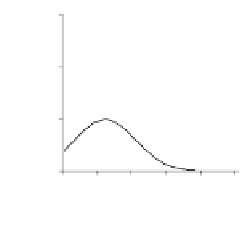Environmental Engineering Reference
In-Depth Information
speed increase. In fact, other motion parameters, such as frequency of directional
changes and frequency distribution of the angles of directional changes, did not show
any dependence on UV-B irradiation
19
.
0,15
Control
0,10
0,05
0,00
0
100
200
300
400
500
Speed [µm/s]
0,15
0,15
O
> 370 nm (30 min)
O
> 370 nm (60 min)
0,10
0,10
0,05
0,05
0,00
0,00
0
100
200
300
400
500
0
100
200
300
400
500
Speed [µm/s]
Speed [µm/s]
0,15
0,6
0,5
O
> 280 nm (60 min)
0,10
O
> 280 nm (30 min)
0,4
0,3
0,05
0,2
0,1
0,00
0
0
100
200
300
400
500
0
100
200
300
400
500
Speed [µm/s]
Speed [µm/s]
Figure 3.
Histograms of the velocity distribution of samples of red B. japonicum cells under different
irradiation conditions (“visible”= Ot 370 nm, “UV-B”= Ot 280 nm) and times (30 and 60 min)
Redrawn from ref. 18.
The UV-B-induced speed increase was a reversible effect, as shown in Fig. 5,
and the time required for speed recovery depended on irradiation time: for short
irradiation time (3 min 45 s, 7 min 30 s, 15 min) the recovery occurred within about one
hour, for longer irradiation time (30 min, 60 min) it occurred within two hours and for
120 min irradiation speed resumed its initial value after three hours only
19
.































































Search WWH ::

Custom Search